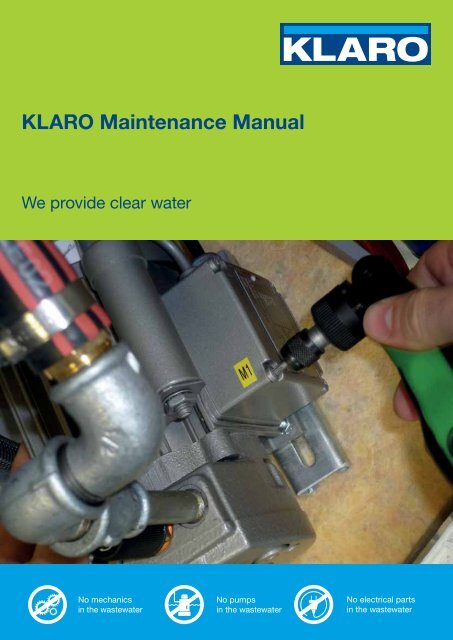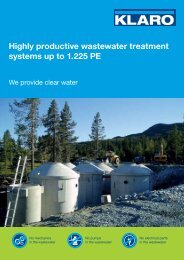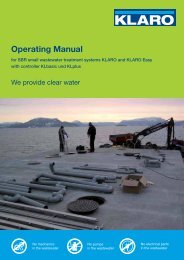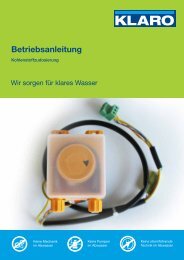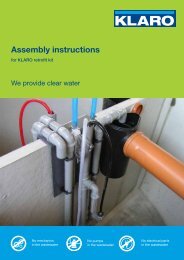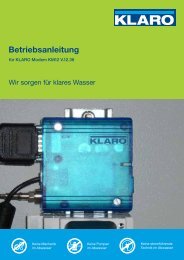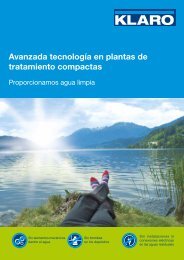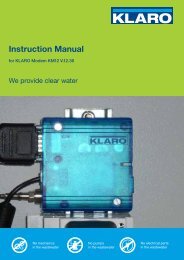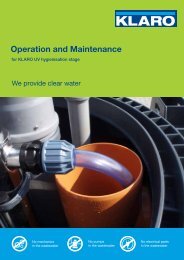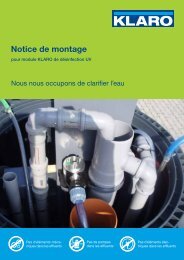KLARO Maintenance Manual - KLARO GmbH
KLARO Maintenance Manual - KLARO GmbH
KLARO Maintenance Manual - KLARO GmbH
- No tags were found...
Create successful ePaper yourself
Turn your PDF publications into a flip-book with our unique Google optimized e-Paper software.
<strong>KLARO</strong> <strong>Maintenance</strong> <strong>Manual</strong>We provide clear waterNo mechanicsin the wastewaterNo pumpsin the wastewaterNo electrical partsin the wastewater
<strong>KLARO</strong> <strong>Maintenance</strong> <strong>Manual</strong>Table of contents1. Introduction2. Safety instructions3. <strong>Maintenance</strong> accessories4. <strong>Maintenance</strong> work in the plant4.1 Visual impression4.2 Analysis of wastewater and sludge4.2.1 Drawing samples from the plant outlet for laboratory analysis4.2.2 Determining the substances that can be deposited (SS 120)4.2.3 Assessing the odour, coloration and turbidity4.2.4 Measuring the water temperature4.2.5 Determining the pH-value4.3 Analysis in the SBR chamber (aeration tank)4.3.1 Determining the volume of sludge (SV 30)4.3.2 Assessment of the aeration pattern4.3.3 Measuring the oxygen concentration4.3.4 Simplified assessment of nitrification and denitrification4.4 Sludge level measurement4.5 Cleaning work5. <strong>Maintenance</strong> of the machines5.1 Air filter5.2 Controller5.2.1 Reading fault messages5.2.2 Power-on hours5.2.3 Reading out data5.2.4 Functional test5.2.5 Setting optimal operational values5.3 Compressor5.3.1 „NITTO“ piston compressor5.3.2 „BECKER“ or „RIETSCHLE“ rotary slide compressor6. Troubleshooting6.1 Poor purification performance6.1.1 Increased SS value6.1.2 Increased COD or BOD 5value6.1.3 Increased NH 4-N value6.1.4 Increased N totvalue6.1.5 Increased P totvalue6.1.6 Increased / decreased pH value6.2 Bulking sludge6.3 Floating sludge and foam6.4 Smells6.4.1 Smell of gas6.4.2 Smell of ammonia6.4.3 Smell of rotten eggs7. <strong>Maintenance</strong> report8. Wastewater parameters445 - 101010 - 111111-12131314141414 - 151616 - 171818 - 19192020202020 - 21212222 - 232323 - 2424 - 25262626 - 2727 - 28282930 - 313132333434343435 - 3637 - 38■■2■■<strong>KLARO</strong> <strong>GmbH</strong>
<strong>KLARO</strong> <strong>Maintenance</strong> <strong>Manual</strong>Table of figuresFigure 1:Figure 2:Figure 3:Figure 4:Figure 5:Figure 6:Figure 7:Figure 8:Figure 9:Figure 10:Figure 11:Figure 12:Figure 13:Figure 14:Figure 15:Figure 16:Figure 17:Figure 18:Figure 19:Figure 20:Figure 21:Figure 22:Figure 23:Figure 24:Figure 25:Figure 26:Figure 27:Figure 28:Figure 29:Figure 30:Figure 31:Figure 32:Figure 33:Figure 34:Figure 35:Visual inspection of the tankMinimum water level reached – the pump cannot be lowered any moreWithdrawing a random sample from the sampling vessel (black) using a bucketDifferent sample bottles - Filling the random sampleFilling the sampleDetermining the substances that may get deposited in the Imhoff funnelRandom sample in a measuring cup for assessing the odour, coloration and turbidityDetermining the pH-value using measurement or test stripsRemoval of a sample of the activated sludge for testing the proportion of sludge by volumeFilling a sample of the activated sludge in the standing cylinderSludge quantity at the beginning of the 30-minute standing timeSludge volume after a standing time of 30 minutesOxygen measuring instrument with the associated probeMeasurement of the oxygen concentration in the sample containerImmersed probe of the oxygen measuring instrument during aerationDisplay unit of the oxygen measuring instrumentTypical trend of the oxygen concentration in the <strong>KLARO</strong> SBR chamber in the course of the dayTypical trend of the oxygen concentration in the <strong>KLARO</strong> SBR chamber with additional denitrificationduring the dayInserting the sludge pipetteSludge level measurement with a sludge pipetteSludge pipette in the storage pipeDetermining the sludge level height with a yardstickRemoving the aeration grateChecking the filter matReading out the data manuallyReading out data via cable and PCReading out data on SD cardOpening the cover of NITTO compressorsChecking the air filterOpen housing for replacing the pistonPistonsChecking the air filterMeasuring the capacitance of the capacitorChecking the sliderP-module in the concrete cabinet1010121212131314151515151616171717171818191920202121212424242425252530List of tablesTable 1:Table 2:Table 3:Table 4:Table 5:Table 6:Table 7:Table 8:Table 9:Table 10:Table 11:Table 12:<strong>Maintenance</strong> accessoriesEvaluation of nitrification / denitrification test stripsAdjustment of aeration timesElimination of increased SS valuesElimination of increased COD or BOD 5valuesElimination of increased ammonia nitrogen valuesElimination of increased total nitrogen valuesElimination of increased total phosphorus valuesElimination of increased/decreased pH-valuesControl of bulking sludgeElimination of floating sludge and foamWastewater parameters■■<strong>KLARO</strong> <strong>GmbH</strong>5 - 1018232728282930 - 3131323337 - 38■■3
The <strong>KLARO</strong> <strong>Maintenance</strong> <strong>Manual</strong>!1. IntroductionAs a result of the robust wastewatertreatment system and with proper operation,the <strong>KLARO</strong> wastewater treatmentplant achieves optimal cleaningor clarification performance and longservice life. It is necessary to checkand maintain the plant regularly forproper operation.The requirements and regulations foroperation and maintenance are notuniform in the EU, but are governedand specified by each country independently.In Germany, these requirements aregoverned and specified by the GermanInstitute for Building Technology (DIBt).They include self-checks and self-testsby the operator of the system as wellas maintenance work by a specialistagency.The self-checks and self-tests aredescribed precisely in the logbookthat is supplied along with every <strong>KLARO</strong>plant. The tasks of the maintenancespecialist are meant to be explainedhere in detail. This manual is to beconsidered as a recommendation. Itis closely in line with the maintenancerules and regulations of the DIBt andis based on more than ten years ofpractical experience that we have withthe <strong>KLARO</strong> SBR technology.Before we begin, what we particularlyrecommend to you is the following:••document and record everymaintenance with the help of the<strong>KLARO</strong> maintenance report (enclosure)••carry out the work steps in thesequence in which they are listedin this manual (and in the maintenancereport)••to note down the serial number ofthe switch cabinet for any queries(is embossed on the nameplate inor fixed on the cabinet)2. Safety instructionsWhile doing maintenance work onwastewater treatment plants, specialprecautionary measures need to beadopted since there may be viruses,pathogenic germs and worm eggs inthe wastewater and on all surfaces thatcome into contact with wastewater.Inadequate or improper hygiene measuresmay lead to diseases (preventionof direct contact with wastewater andsurfaces coming into contact with it).The precautionary measures include:••Wearing protective gear or safetyclothing.••Wearing hygienic hand gloves.■■4■■<strong>KLARO</strong> <strong>GmbH</strong>
Wash and sterilise hands afterthey come into contact withwastewater.••Vaccination for tetanus and hepatitisB.••Consulting a doctor if wastewaterhas been swallowed.••Entry into the plant by any personmust be safeguarded by anotherperson, since you need to reckonwith harmful gases within theplant.••Do not drink or eat while working.3. <strong>Maintenance</strong> accessoriesWe have compiled a list of equipment, tools and spare parts that you should keep in order to be able to carry out maintenanceprofessionally.<strong>Maintenance</strong> accessories Characteristics FigureSludge pipette••Determining the sludge levelin the pre-clarification / sludgestorage••DN40; 2 m + 1 mBuckets + telescopic extractionstick••Withdrawal of bailed samplesfrom the plant outlet from theintegrated sampling facility andsludge samples (SV 30) from theSBR tank;••Plastic cup, 500 ml,••Telescopic rod, 1.0 – 3.0 m■■<strong>KLARO</strong> <strong>GmbH</strong>■■5
<strong>KLARO</strong> <strong>Maintenance</strong> <strong>Manual</strong>Measuring cylinder••Determining the proportion byvolume of the sludge (SV 30)••1,000 ml, Ø 65 mm••Plastic or glass cylinder, graduatedand completely transparentImhoff funnel + holding frame••Determining the substances thatcan be deposited (SS 120)••Glass funnel with division••1,000 mlMeasuring cup••Determination of odour, colorationand turbidity••Glass cup with divisions andspout, 1,000 mlSampling bottles + refrigerationbox••Sealable wide-neck bottlesmade of HDPE••For laboratory analyses••1,000 ml for BOD 5and SS 120••500 ml for COD, N, P (transferredwith 2 ml H 2SO 4)COD cuvettes••Reagent cuvettes with chemicalsfor photometric COD measurementCOD photometer••Analysis of the COD valueSafety glasses••Eye protection when handlingdangerous chemicalsOxygen measuring instrument,HACH LANGE HQ30d with sensorLDO101••Measurement of dissolved oxygen[mg/l] in the activation tankand sampling; combined withtemperature measurement [°C]■■6■■<strong>KLARO</strong> <strong>GmbH</strong>
<strong>KLARO</strong> <strong>Maintenance</strong> <strong>Manual</strong>••Measurement of ammoniumAmmonium test strips••Assessing whether the aerationis enough••Measuring range: 0 to 400 mg/l••Measurement of nitrateNitrate / nitrite test strips••Measuring range: 0 to 500 mg/l••Measurement of nitrite••Measuring range: 0 to 80 mg/lPhosphate test strips••Measurement of total phosphate••Measuring range: 0 to 80 mg/lpH measurement strips••Determining the pH value••100 pieces••Measuring range: pH 4.5 - 10Hygiene hand gloves••Protecting the hands from germsSterilisation agent••Protecting the hands from germsManhole cover remover••Removal of shaft covers made ofconcrete / cast ironSocket wrench••Socket wrench, 17 mm, for openingsmall shaft covers made ofPE■■<strong>KLARO</strong> <strong>GmbH</strong>■■7
<strong>KLARO</strong> <strong>Maintenance</strong> <strong>Manual</strong>Tape measure••Determination of the sludge levelheight and water levelsCabinet key••Opening all <strong>KLARO</strong> switchingcabinets for indoor and outdoorinstallationScrewdriver••Philips (slotted) screwdriver fordismantling the controller (outdoorcabinets)••Blade length: at least 14 cmSocket wrench••Socket wrench for fasteninghose clamps••7 mmSD card••Reading from controller (KLpluscontroller)Hose clamps••Fastening hose pipes••13 / 19 mmInterface cable••Reading from the controller (ZK,ZKplus and KLbasic controllers)Multimeter••Measuring capacitance, voltage,current and conductance■■8■■<strong>KLARO</strong> <strong>GmbH</strong>
<strong>KLARO</strong> <strong>Maintenance</strong> <strong>Manual</strong>Smoke cartridge••Testing the bleeding of the plantWork gloves••Protecting the hands while workingon the plantBattery••Replacement batteries for theZK and ZKplus controllers••9VControllers••Spare controllers (KLbasic andKLplus) including the connectioncablesSolenoid valve••Spare coil with armature andspring••with a straight stem from 07/2002to 05/2006••with conical stem from 06/2006Air filter for the Nitto compressor••Replacement of clogged air filtersof a piston (or reciprocating)compressor, NITTO••different sets for LA60/80, LA120and LA200Micro-fuses••2 A (slow speed), 8 A (mediumspeed)Disc aerator••Replacement of defective discaerators■■<strong>KLARO</strong> <strong>GmbH</strong>■■9
<strong>KLARO</strong> <strong>Maintenance</strong> <strong>Manual</strong>Cooling fan••As a spare for cabinets with arotary slide compressor or to retrofitcabinets with reciprocatingcompressorsGrommets••As replacement if grommetsbreak off••Angled or straightSealing tape••In order to reseal hose connectionsand threadsTable 1: <strong>Maintenance</strong> accessories4. <strong>Maintenance</strong> work in the plant4.1 Visual impressionFigure 1: Visual inspection of the tankFigure 2: Minimum water level reached – the pump cannotbe lowered any moreAfter opening the shaft manhole cover,you first obtain an overview of the visualimpression of the <strong>KLARO</strong> plant.You need to take decisions regarding:••the general accessibility to theplant■■10 Shaft manhole cover can bereached easily / not delivered••the condition of the shaft manholecover Breakages, cracks, functionality ofthe child lock for PE covers…■■<strong>KLARO</strong> <strong>GmbH</strong>••the condition of the feed pipes anddrain pipes Any signs of clogging••the completeness and proper arrangementof the components installed
<strong>KLARO</strong> <strong>Maintenance</strong> <strong>Manual</strong> Aeration equipment, air-lift pump,air hose pipes and sampling••the water levels of the individualchambers Any signs of overflow in the chambers,hydraulic overload and problemswith the air-lift pumps••possible formation of floatingsludge in the aeration chamber––Surfactant foam:solid, white foam, that remains stablewhen touched Indication ofthe use of excessive detergent ofwashing agent––Egg-white foam:greyish foam, which collapses immediatelywhen touched An indication that there is biologyin the build-up; often observed duringthe start-up phase.••Signs of grease deposits, especiallyin case of restaurants Grease separator overloaded ordisposal is due••the aeration and bleeding of theplant via the building roof, shaft manholecover or other aeration equipment••the leak-tightness of the tank externally Ingress of drainage water and highwater levels; any signs of leakage ifthe level falls below the „minimumwater level“••Any signs of possible corrosiondamage particularly in the case of concretetanks; accompanied in most caseswith technical problems and lack ofaeration and bleeding.4.2. Analysis of wastewater and sludge4.2.1 Drawing samples from the plant outlet for laboratory analysesA random sample of the discharge fromthe plant is withdrawn for subsequentlaboratory analyses. For this purpose,wastewater is carefully withdrawn withthe help of a bucket from the integratedsampling vessel (not the SBR chamber!).While doing so, do not touch the wallsof the vessel for drawing samples, sinceotherwise deposits come loose andworsen the sample disproportionately.The random sample is filled carefullyinto the sealable sample bottle. Thereare different sample bottles dependingon the laboratory and the parametersto be analysed.••To determine the quantity of BOD 5the bottle must be filled completelyand without any bubbles as faras possible. To do this, tap on thefilled and open bottle, so that theair bubbles get released from theedge of the bottle. Fill up the samplebottle once again until it overflows.Close the cap at this stage.••For the determination of COD,N and P compounds, often bottlesare used that already containsulphuric acid (H 2SO 4). As a result,all decomposition processescease and there is no falsificationin the analysis resulting from theperiod of transportation to the laboratory.••To determine the quantity of SS,about 0.5 litres of the randomsample must be filtered and thefilter residue must be weighed. Ingeneral, glass fibre filters or paperfilters having pore widths of 0.3to 1 µm are used for the filtration.This is why the same random samplemay be used for determiningthe quantity of BOD 5. No separatesample bottle is required for thispurpose.••An exact quantity of 1.0 litre ofwastewater is needed to determinethe quantity of SS 120. This iswhy we recommend that you fill anadditional random sample in anothersample bottle for the exactdetermination of the substancesthat can get deposited. The randomsample must be removed carefullyfrom the bottle and storedunder refrigeration until the analysisis conducted.■■<strong>KLARO</strong> <strong>GmbH</strong>■■11
<strong>KLARO</strong> <strong>Maintenance</strong> <strong>Manual</strong>Figure 3: Withdrawing a random sample from the sampling vessel (black) using a bucketFigure 4: Different sample bottles - Filling the random sampleFigure 5: Filling the sampleThe sample bottles must be labelledin a comprehensible manner (Name /Date / Place).Finally, the samples must be kept underrefrigeration and stored in a dark place.A refrigeration box with a cold pack isideal for this purpose. The samplesshould be brought to the laboratory assoon as possible since the compositionmay change with time.The parameters with respect to whichthe samples should be analysed dependon the local requirements. Theenclosure (or appendix) contains anoverview of typical wastewater parametersand values, which are meantto assist you with the interpretation ofthe measured values.■■12■■<strong>KLARO</strong> <strong>GmbH</strong>
<strong>KLARO</strong> <strong>Maintenance</strong> <strong>Manual</strong>4.2.2 Determining the substances that can be deposited (SS 120)The substances that may get deposited(SS 120) contained in the randomsample, indicate the proportion of thesolid content and include undissolvedcontaminants that may get deposited.The quantity of substances that may getdeposited is determined in an Imhofffunnel (coneshaped glass). The Imhofffunnel must be placed upright in a framefor this purpose. The random sampleis filled up to the 1,000 ml mark in theImhoff funnel. The quantity of substancesthat may get deposited must bedetermined by reading the volume ofsubstance at the tip of the funnel aftera standing time of 2 hours.Since solid substances get depositedon the slanted wall of the funnel, it isturned to and fro with a jerk 15 minutesprior to the completion of the standingtime.The quantity of the substances thatmay get deposited should not be morethan 0.3 ml/l.Since the determination of the substancesthat may get deposited takes 2hours, we suggest that this measurementshould not be carried out at sitebut in your own factory or laboratory.Until then, the sample must be keptunder refrigeration.Figure 6: Determining the substancesthat may get deposited in theImhoff funnel4.2.3 Assessing the odour, coloration and turbidityTraditional property parameters of awastewater sample are the odour, colorationand turbidity. The assessmentof these semi-qualitative parametersreflects an excellent method of recordingthe condition of the treatment orcleaning performance of a wastewatertreatment plant, without using measuringinstruments.It is best to evaluate the parametersimmediately after withdrawing the randomsample.OdourFor the odour test, the measuring cupmust be shaken with the sample filled.The type of the odour is differentiatedsubsequently (none, weak, strong orintense). The sample should have aneutral or earthy smell. If it smells ofmoulds or has a foul or sanious smell,the cleaning power of the wastewatertreatment plant is faulty (e.g. on accountof inadequate aeration).ColorationTo assess the coloration, the colourstrength and the shade of the colourare viewed against a white backgroundand evaluated. The random sampleshould be clear to yellowish. A brownor grey coloration indicates inadequatecleaning or treatment.TurbidityTurbidity means the weakening of radiationpassing through the sample.Turbidity is caused by suspended solids.To assess the turbidity, the randomsample must be held in a measuringcup against sunlight and the weakeningof the light radiation needs to beevaluated. If there are no suspendedsolids in the random sample, the samplehas no turbidity. If, on the contrary,there are plenty of suspended solidsin the random sample, it becomeshighly turbid. Intense turbidity or alarge amount of suspended solids area sign of sludge output.Figure 7: Random sample in a measuringcup for assessing the odour,coloration and turbidity■■<strong>KLARO</strong> <strong>GmbH</strong>■■13
<strong>KLARO</strong> <strong>Maintenance</strong> <strong>Manual</strong>4.2.4 Measuring the water temperatureA scoop thermometer must be used formeasuring the temperature. This mustbe held for 1-2 minutes in the randomsample. Since the temperature is alsomeasured with the oxygen measuringinstrument, the scoop thermometermay be dispensed with.4.2.5 Determining the pH-valueThe pH-value is the easiest to measurewith special test strips. You only needto immerse the test or measurementstrip in the random sample. As soonas the test strip has been dipped in thesample, it takes up a certain colour.This colour now needs to be comparedwith the colour scale.There are two types of measuring or teststrips (universal and special test strips).The universal test strip can measurepH-values in the range between 1 and12. The special test strip measures thevalue in a smaller range (e.g. pH 5 - 8)and has greater accuracy.In addition, measuring instruments areavailable, which measure the pH-valuein multiples of 0.1 pH after calibration.The pH-value should lie in a weaklyalkaline range between 6.5 and 8.0.Figure 8: Determining the pH-valueusing measurement or test strips4.3 Analysis in the SBR chamber (aeration tank)Apart from removing a random sample,direct analyses also need to be carriedout in the activation tank.••Proportion of sludge by volume••Assessment of the aeration pattern••Oxygen concentrationFor this purpose, the aeration of the activationtank must be active or switchedon in manual operation mode (Valve 2).4.3.1 Determining the volume of sludge (SV 30):The sludge volume is equivalent tothe volume of 1 litre of the activatedsludge after a settling down period of30 minutes.The volume of sludge is a measureof the quantity of biologically activesludge. This value is an important parameterin the field of wastewater analysis,since the performance capabilityof the activation plant is controlled bythe sludge volume.For determining the volume of sludge(SV 30), the aeration of the activation tankmust be active or it must be switchedon in manual mode (valve 2).As soon as the activation tank is wellmixed, a sample of the activated sludgecan be removed with the help of a bucketfrom the activation tank.The sample withdrawn must be filledin a standing cylinder up to the 1,000ml mark.The sample filled in the standing cylindermust now be kept upright withoutany vibrations and protected from directsunlight for 30 minutes.■■14■■<strong>KLARO</strong> <strong>GmbH</strong>
<strong>KLARO</strong> <strong>Maintenance</strong> <strong>Manual</strong>Figure 9: Removal of a sample of the activated sludge for testing the proportion of sludge by volumeFigure 10: Filling a sample of the activatedsludge in the standing cylinderFigure 11: Sludge quantity at the beginningof the 30-minute standing timeFigure 12: Sludge volume after a standingtime of 30 minutesThe volume of sludge is rounded off to10 ml/l. If the volume of sludge is morethan 250 ml/l, the measurement mustbe repeated after dilution.For this purpose, the activated sludgesample is diluted with wastewater. Thesample now diluted should have asludge volume between 200 and 250ml/l. The new measured value obtainedmust be multiplied with a dilution factor.It is sufficient to make only one measurementto determine the sludge volume.This measurement reasonablyreflects the volume of the sludge inthe activation tank of the SBR plant.This is why we recommend to dilutethe sludge sample and to repeat themeasurement if the sludge volume ismore than 250 ml/l.However, after 30 minutes, if the sludgevolume in the standing cylinder is morethan 400 ml/l, the period of sludgerecirculation must be increased. If thesludge volume is considerably below the200 ml mark, the recirculation periodmay be reduced or disabled completely.■■<strong>KLARO</strong> <strong>GmbH</strong>■■15
<strong>KLARO</strong> <strong>Maintenance</strong> <strong>Manual</strong>4.3.2 Assessment of the aeration pattern:In order to assess the functionality ofthe wastewater aeration, the aerationand bubble pattern in the activationtank is observed while aeration is beingdone. Pay attention to the followingcharacteristics:••Moderate Intensive, circulation is clearlyidentifiable••Coarse bubbles Fine bubbles••One-sided Moderate (if multiple membraneaerators have been installed in thetank)4.3.3 Measuring the oxygen concentrationThe oxygen content in the activationtank or the random sample is an importantcontrol parameter for wastewatertreatment plants. The oxygenconcentration is obtained with the helpof measuring instruments, for whichcertain basic knowledge (calibration,maintenance, and storage) is required.The user manual of the measuringinstrument must be studied for thispurpose. The measured values arehighly accurate when they are usedproperly.Figure 13: Oxygen measuring instrumentwith the associated probeMeasurement in the sample containerHold the measuring probe of the oxygenmeasuring instrument in the samplecontainer and take a new measurement.The oxygen concentration should beat least 2 mg/l.In case of substantial deviations, theaeration time of the controller must beadjusted ( see the section „Settingoptimal operational values“).We recommend:••O 2< 2 mg/l Increase the aeration••O 2= 2 to 6 mg/l Do not modify the aeration••O 2> 6 mg/l Reduce the aerationYou need to consider also the following:••There may be fluctuations dependingon the season. The dissolutionbehaviour of oxygen is betterin cold weather than in warm weather.Hence, the measured valuesin winter are often somewhat higherthan in summer.••The oxygen concentration also dependson the quantity of the activatedsludge ( SV 30). If the quantityof activated sludge increases,more oxygen is consumed andthe oxygen concentration comesdown. This aspect must be kept inmind particularly in plants havingseasonal fluctuations and whenthe time for sludge recirculation inthe controller is modified.Figure 14: Measurement of the oxygenconcentration in the sample container■■16■■<strong>KLARO</strong> <strong>GmbH</strong>
<strong>KLARO</strong> <strong>Maintenance</strong> <strong>Manual</strong>Measurement in the activation tankThe aeration of the activation tank remainsswitched on for the measurementof the oxygen concentration. The probeof the measuring instrument must nowbe immersed in the activation tank.The measuring instrument may bestarted now. It measures the contentof oxygen dissolved in the wastewaterautomatically.Figure 15: Immersed probe of the oxygen measuring instrumentduring aerationFigure 16: Display unit of the oxygen measuring instrumentSince the SBR process in the activationtank for wastewater treatment orcleaning takes place in four differentphases one after another chronologically(feeding, aeration, sedimentationand extraction), the oxygen concentrationincreases during the aerationphase. Before and after the aerationphase, that is, during the feeding, sedimentationand extraction phase,the oxygen concentration reduces, incontrast (see the following diagram forthis purpose).Figure 17: Typical trend of the oxygen concentration inthe <strong>KLARO</strong> SBR chamber in the course of the dayFigure 18: Typical trend of the oxygen concentrationin the <strong>KLARO</strong> SBR chamber with additionaldenitrification during the dayIn <strong>KLARO</strong> SBR-plant that have alsobeen designed for denitrification, shortbursts of aeration are used, prior to theactual aeration, to achieve circulationof the activation tank (the so-calledpre-aeration phase). In the process,the denitrified microorganisms arestimulated to convert nitrate into itselement, nitrogen. The oxygen concentrationreduces considerably during theDeni-phase (O 2≈ 0 mg/l). In order toensure optimal denitrification, the oxygenconcentration should not be morethan 0.5 mg/l during the denitrification.Thus, the oxygen concentration in theactivation tank of the wastewater treatmentplant depends on the respectivephase of the SBR process and a moreaccurate interpretation of the oxygenconcentration measured - directly fromthe tank – is often very difficult. This iswhy we recommend that the oxygenconcentration be determined in thesample container.■■<strong>KLARO</strong> <strong>GmbH</strong>■■17
<strong>KLARO</strong> <strong>Maintenance</strong> <strong>Manual</strong>4.3.4 Simplified assessment of nitrification and denitrificationIn order to quickly and easily assessthe effectiveness of the nitrification/denitrification, semi-qualitative teststrips can be used as an aid. Here,a test strip (for ammonium or nitrate/nitrite) is always dipped into thetaken sample. Afterwards, the concentrationcontained in the samplecan be compared on the basis of acolour scale. The more the test stripchanges its colour, the higher is theconcentration. In order to define theeffectiveness of the nitrification (NH 4-N degradation), a sample is takenfrom the pre-clarification chamber/sludge storage (first chamber) andan effluent sample from the outletis taken from the sample container.The concentration of the sample fromthe pre-clarification chamber/ sludgestorage should be approx. 50 mg/land the concentration of the effluentsample from the outlet < 10 mg/l. Ifthe concentration of the sample fromthe pre-clarification chamber/sludgestorage is much higher than 50 mg/l,the inlet conditions must be examined.Pre-clarification /sludge storageEffluent sample fromthe outletResultNitrificationNH 4contentDenitrificationNO 3contentca. 50 mg/l< 10 mg/lgood nitrification, O 2content sufficientlyca. 50 mg/l > 10 mg/l poor nitrification> 50 mg/l > 10 mg/l poor nitrificationca. 0 mg/l < 50 mg/l excellent denitrificationca. 0 mg/l < 100 mg/l good denitrificationca. 0 mg/l> 100 mg/linsufficient denitrificationTable 2: Evaluation of nitrification/denitrification test stripsNote: The result of the test stripsis specified as NH 4and/or NO 3. Thethreshold values are usually specifiedas NH 4-N and/or NO 3-N.4.4 Sludge level measurementThe sludge level height in the preclarification/ sludge storage has a directimpact on the cleaning or treatmentperformance of a wastewater treatmentplant or septic tank. This is why it isindispensable to check the sludgelevel height. The level is measured withthe help of a sludge dip-stick (acrylicglass tube).For this purpose, you need to shift thelayer of floating sludge to the side anddip the transparent sludge dip-stick withthe open valve in the pre-clarification /sludge storage right up to the base ofthe tank. The valve is closed by pullinga control cable (provided with a ballvalve) or with a forceful jerk (in case ofa non-return valve), and the dip-stickmay now be pulled out again.Figure 19: Inserting thesludge pipetteFigure 20: Sludge level measurementwith a sludge pipette■■18■■<strong>KLARO</strong> <strong>GmbH</strong>
<strong>KLARO</strong> <strong>Maintenance</strong> <strong>Manual</strong>Figure 21: Sludge pipette in the storage pipeThe contents of the chamber are reproducedin the sludge pipette as aclosed column. The sludge layer of thepre-clarification sludge storage canthus be read directly. To do this, thesludge layer - the solid constituents -must be clearly identifiable from thesolid-free zone.The sludge height is recorded in thereport. It is required to arrange forproper disposal of the sludge fromthe pre-clarification sludge storagefor proper operation. It is necessaryto dispose of the sludge storage latestwhen 70% of the sludge storage is filled.The attention of the operator must bedrawn to the need for disposal.The sludge removed with the help ofthe sludge pipette must be emptiedout again in the pre-clarification sludgestorage. By immersing the pipette againin the aerated chamber, it becomesclean inside.The sludge pipette, at best, must bestored in a PVC pipe after use for thesake of hygiene. The storage pipe issealed at the bottom side with a stopperin order to trap any residual liquid.4.5 Cleaning workFigure 22: Determining the sludge levelheight with a yardstickFinally, general cleaning work shouldbe done within the plant:••Removing deposits••Clearing any clogging or jamming••Replacing damaged installedcomponents or kinked hose pipes••Skim off the floating sludge on theactivation chamber and put in thepre-clarification/sludge storage■■<strong>KLARO</strong> <strong>GmbH</strong>■■19
<strong>KLARO</strong> <strong>Maintenance</strong> <strong>Manual</strong>5. <strong>Maintenance</strong> of the machines5.1 Air filterThe filter for aerating the switch cabinet(aeration grate on the left andright side of the housing wall in theindoor cabinet or on the back side inthe outdoor cabinet) must be checkedand cleaned or replaced if necessary.To do this, the grate outside the cabinetmust be removed. The clamp lockmust be loosened by pressing lightlywith a screwdriver and the grate mustbe pulled by hand. The filter mat lies inthe ventilation shaft without any otherfixture and may be shaken or blown off.NOTE:Clogged or choked filter mats impairthe aeration and bleeding efficiencyof the switch cabinet. Permanentconsequences may include:••Overheating in the cabinet (Temperature alarm of the controllergets triggered)••Increased wear and tear of theelectrical components, particularlythe compressor and solenoidvalves••Reduced oxygen inlet by the compressorinto the wastewater treatmentplantFigure 23: Removing the aeration grateFigure 24: Checking the filter mat5.2 Controller5.2.1 Reading fault messagesYou need to check the faults that haveoccurred since the time of the previousmaintenance in the logbook of the controller.To do this, call up the followingin the operator menu of the controller:••„read out old errors“ (for KLplusand ZKplus)••„Display errors or faults“ (forKLbasic and ZK)This is where the latest message isdisplayed with the date and time. Bypressing the or button,you can go to the previous messages.NOTE:There is a capacity to store 128messages. If this number has beenreached, every new message deletesthe oldest one. The memory may bedeleted by the maintenance technicianin the service menu using the„clear logbook“ command.5.2.2 Power-on hoursThe total power-on hours of the loads(valves, compressors, …) as well as theutilisation (only for KLplus and ZKplus)must be read out and recorded.■■20To do this, call up the following in theoperator menu of the controller:■■<strong>KLARO</strong> <strong>GmbH</strong>••„operating hours meter reading“(for KLplus and ZKplus)••„operating hours report“ (forKLbasic and ZK)
<strong>KLARO</strong> <strong>Maintenance</strong> <strong>Manual</strong>The power-on hours of the compressorprovide an indication of whether it isdue for maintenance.The „work load xx%“ (only in KLplusand ZKplus) provides the ratio of howmany treatment cycles have actuallybeen executed. A standard plant completesfour cycles per day = 100%. Thedisplay primarily serves the purpose ofplausibility check to see whether thefunction „level measuring“ has beenset meaningfully.5.2.3 Reading out dataReading out data via cable and PCThe logbook of the controller may beread out on external storage media.There are the following options availableat site for this purpose:Reading out with cable + PC (all <strong>KLARO</strong>controllers)To read out the logbook via cable, youneed the following at site:••PC (Laptop)••Serial read cable, RS-232••Possibly, USB - serial adapter••Reading software <strong>KLARO</strong>@komTo read out the data, the RS-232connector of the cable connected tothe socket on the back side of thecontroller. With the help of the KLA-RO@kom software, data is transmittedand transferred to preformatted Excelspreadsheets. These spreadsheets maybe edited, saved and printed out, e.g. asan enclosure to a maintenance report.Reading out with an SD card (only KLplus)In order to read the data, the rubberstopper at the front of the controller isremoved and an SD memory card isinserted into the free slot. In order tostart the data transmission, you needto switch to the service menu to the„SD Card“ option and confirm with. As soon as the data has beentransmitted completely, the display „SDCard OK“ appears. Now, by pressingonce again, you can exit fromthe service menu and remove the SDmemory card. Finally, seal off the cardslot in the controller carefully in orderto prevent the ingress of moisture.The data read out in the PC is transferredwith the help of the <strong>KLARO</strong>@kom software from a PC to preformattedExcel spreadsheets. Thesespreadsheets may be edited, savedand printed out, e.g. as an enclosureto a maintenance report.Figure 25: Reading out the data manuallyFigure 26: Reading out data via cableand PCFigure 27: Reading out data on SD card■■<strong>KLARO</strong> <strong>GmbH</strong>■■21
<strong>KLARO</strong> <strong>Maintenance</strong> <strong>Manual</strong>5.2.4 Functional testIn the „<strong>Manual</strong> Mode“ menu, you canswitch the loads on briefly and thenagain off to test all of them one afteranother. A malfunction in the electricalsystem is indicated by the controller asa fault. Proper working of the componentsshould be checked visually in thewastewater treatment plant.NOTES:••In the ZK and ZKplus controllers,the 9V battery is checkedin parallel in the background.••With the underloading detectionactivated in the KLplus andZKplus controllers, the level ismeasured when valve 1 is in manualmode.••As an alternative to switchingthe valves 1-4 manually, theoption „operation test“ may beactivated in the service menu.After a waiting period of twominutes, the controller automaticallyswitches the valves 1-4on for a few seconds and thenagain switches them off.Be careful when withdrawing an outletsample! During the functional testfor valve 3, the air lift generally transferscontaminated or water that hasnot settled adequately from the SBRchamber into the integrated samplingfacility. Sampling for laboratoryanalyses is then no longer possible.Hence, always remove samples PRI-OR to the functional test!5.2.5 Setting optimal operational valuesThe controllers are preset with theloading embossed (PE number) andthe class of treatment of cleaning. Inthe process, for the sake of safety,continuous maximum loading of theplant is assumed. The controller settingsmay be adjusted to the actualconditions at site. We recommend thatsuch adjustments are made only aftera safe start-up phase, for example, inthe course of the first maintenance. Ingeneral, considerably lower runningtimes may be achieved as a result.Control to lower levels should be done insmall steps and recorded in the logbookor the maintenance report so that youcan track the modification at the timeof the next maintenance.Typical adjustments are:••Adjustments of the PE number orcleaning (treatment) class. Thecurrent values set are displayedin the „setup report“ menu, forexample, „<strong>KLARO</strong> 8 EW C“. Anyother table may be selected in theservice menu and activated bypressing .NOTES:––The new table selected is displayedin the „setup report“menu only when the old cyclehas ended or has been interruptedby the „restart the cycle“function.••An overview of all controller tablesis given in the enclosure or appendix.The controller has a capacityto hold maximum 25 tables orspreadsheets. Tables or spreadsheetsmay be copied with thehelp of <strong>KLARO</strong>@kom-Tool for specialapplications. Consult <strong>KLARO</strong>for this purpose.••Adjustment of the aeration timesin order to reduce or increase theentry of oxygen during the aerationphase, the clock cycle „AerationON T6“ and „Aeration OFFT7“ may be changed in the servicemenu under the option „durationperiod setup“.NOTES:––When modifying a clock cycletime, always confirm with––The modified cycle times aredisplayed in the „setup report“menu only when the old cyclehas ended or has been interruptedby the „restart the cycle“function.––KLbasic and KLplus displaythe current aeration periodset currently in hours per daywith T18. Modifications in theaeration times can be trackedeasily here.––The „Aeration phase T5“ remainsuntouched. Increasingit may lead to the maximumpermissible total cycle timegetting exceeded. This thenleads to loss of the next cycle(the controller switches to„Cycle pause“) and to reductionin the total aeration periodfor the day.••Adjusting the number of cleaningor treatment cycles. In case ofplants that are constantly underloaded(e.g. only one person athome), the number of cleaning ortreatment cycles may be reducedfrom four cycles to two cycles.You can achieve this most easilyby increasing the cycle time for the„Settlement phase T8“ from thedefault setting of „90 min.“ to „100min.“. As a result, the maximumtotal cycle time permissible getsexceeded and only every secondcycle gets executed. In between,the plant switches to the „Cyclepause“ status.■■22■■<strong>KLARO</strong> <strong>GmbH</strong>
<strong>KLARO</strong> <strong>Maintenance</strong> <strong>Manual</strong>••Adjusting the sludge recirculationtime. The period of the sludgerecirculation may be reduced orincreased via T12. In the ZK andZKplus, this is done in steps of minutes.In the KLbasic and KLplus,this may be set to the nearestsecond. The sludge recirculationtime should be changed by amaximum of one minute or 60 seconds.••Adjusting the underloading feature(only in ZKplus and KLplus).The underloading feature servesprimarily to conserve energy. Thefill level, which leads to the commencementof a cleaning or treatmentcycle, may be adjusted inthe service menu under „Adjustfill level measurement“. The „workload“ in the „operating hours meterreading“ menu provides an indicationof the actual ratio of thecleaning cycles to the pause cycles.Adjustment options:––Reduce „water level start at: xxxcm“ if: the loading level displayedis low, fill levels in the tanks, however,are high and the dischargequality is unsatisfactory––Increase „water level start at: xxxcm“ if: the loading displayed ishigh, the fill levels in the tanks,however, is low, the dischargequality is good but the plantoperator is dissatisfied with theenergy conservation.EXAMPLE:Clock cycle Function ACTUAL value Reduce IncreaseT 5 Aeration phase [min] 250 250 250T 6 Aeration on [min] 4 3 5T 7 Aeration off [min] 6 7 5Table 3: Adjustment of ventilation times5.3 CompressorThe maintenance work and intervals depend on the type of compressor.5.3.1 „NITTO“ piston compressorDetailed instructions on the operationand maintenance as well as drawingsare given in the Operating <strong>Manual</strong>.We recommend the following for maintenance:••Checking the air filter with EVERYmaintenance••Replacing the piston set after25,000 hours of operationNOTES:––If the compressor is operatedbeyond the 25,000 hours ofoperation, the air compressioncapacity may get impaired.This must be compensated byincreasing the aeration period.If tinkling or tapping noisescan be heard, the piston setmust be replaced immediately,otherwise the equipmentmay get damaged irreparably.––There is a video clip availablethat demonstrates the maintenanceof the compressor in anillustrative manner. You maysend us a request for a copyfree of charge.■■<strong>KLARO</strong> <strong>GmbH</strong>■■23
<strong>KLARO</strong> <strong>Maintenance</strong> <strong>Manual</strong>Figure 28: Opening the cover of NITTO compressorsFigure 29: Checking the air filterFigure 30: Open housing for replacingthe pistonFigure 31: Pistons5.3.2 „BECKER“ or „RIETSCHLE“ rotary slide compressorDetailed instructions on the operationand maintenance as well as drawingsare given in the Operating <strong>Manual</strong>.We recommend the following for maintenance:••Checking the air filter with EVERYmaintenance, but at least semiannually––Omitted for the smaller design,BECKER DT 4.4 – 4.8––Blow off or replace contaminatedair filtersNOTE:A clogged or choked air filter leadsto reduced air compression capacityand cooling of the equipment.■■24■■<strong>KLARO</strong> <strong>GmbH</strong>
<strong>KLARO</strong> <strong>Maintenance</strong> <strong>Manual</strong>Figure 32: Checking the air filter••Checking the slider width at leastevery 3,000 hours of operation.––Record the slider width measuredin the maintenance reportin order to be able to track wearand tear and procure spare slidersin time.NOTE:If the slider width goes below theminimum permissible value, therest of the slider may break andblock the rotor.••Checking the starting capacitor atleast every 3,000 hours of operation.––Disconnect the capacitor––Use a multimeter (with capacitancemeasurement feature) withcrocodile clips. For measuringleads having test tips, you shoulduse a clamp (see figure) for assistance.Measurement directlyon the terminal board will distortthe result just as when you useyour fingers to press the test tipson the leads of the capacitor.––Target value [mF] is embossedon the nameplate of the compressorNOTE:The starting capacitor causes thecompressor to run in the right directionwhen it is switched on. A worn(very weak) capacitor may start thecompressor in the wrong direction(suction instead of compression).Figure 33: Measuring the capacitanceof the capacitorFigure 34: Checking the slider■■<strong>KLARO</strong> <strong>GmbH</strong>■■25
<strong>KLARO</strong> <strong>Maintenance</strong> <strong>Manual</strong>6. Troubleshooting6.1 Poor purification performanceA poor purification performance alongwith a possible exceedance of limitvalues is an indicator of the small wastewatertreatment plant either not workingcorrectly or increased pollutant levelsin the feed.A properly planned and regularly maintainedsmall wastewater treatment plantwhich is not subject to overloadinggenerally exhibits very stable purificationbehaviour.Malfunctions need to be expected if themeasured values are not in the usualrange of variation or are higher thanthe anticipated values. If limit valuesare exceeded, action must be taken.Before considering operational or structuralchanges, the measured valuemust first be checked for plausibility.If increased levels are measured at theoutlet of the small wastewater treatmentplant, the first thing to be checkedshould be the execution of sampling.In the case of random samples, it mustbe ruled out that.••the sample container containedresidues of cleaning agents oranother sample,••too many solids are present in thesample due to contamination ofthe integrated sampling unit, thedipper or the sample containerleading to distortion,••a mix-up could be possible becauseof missing, inappropriate orincorrect identification of the samplecontainer.NOTE:When taking samples by means of adipper, it must be ensured that thedipper does not scratch the bottomduring the scooping movement or thewalls when inserting and removingthe dipper.If the results are implausible, a secondmeasurement must be performed.If the increased outlet valuemeasured is plausible and if thereis no overloading of the small wastewatertreatment plant, the causeof the present malfunction must bedetermined. When doing so, keep inmind that it does not always have tobe a single cause which is responsiblefor elevated measured values.Increased outlet values may alsobe due to the combined effect ofseveral causes.6.1.1 Increased SS valueIf the small wastewater treatmentplant is adequately dimensionedand the bioreactor works smoothly,the SS value at the outlet should beabout 10 mg/l. Consequently, an increasedsolids overflow only appliesif the SS value exceeds 30 to 50 mg/lat the outlet.The most common causes for an elevatedSS value are:••Full primary settlement chamber/sludge storage,••Increased solids concentration inthe bioreactor (SV 30> 400 ml/l),••Sludge bulking,••Floc disintegration,••Hydraulic overload.■■26■■<strong>KLARO</strong> <strong>GmbH</strong>
<strong>KLARO</strong> <strong>Maintenance</strong> <strong>Manual</strong>Observation Cause EliminationIncreased SS valueTable 4: Elimination of increased SS valuesIncreased solids concentration inthe bioreactorSludge bulkingFloc disintegrationHydraulic overloadFull primary settlement chamberGradually increase excess sludgerecirculationIncrease oxygen supplyAdjust pH by means of lime, soda orcaustic soda.Check feed for inhibiting substances(disinfectants, medicaments, foodresidues, residues from renovationwork: paint, paste, etc.)Check the inlet volumes.Check built-in and electrical components(switch cabinet)Arrange for desludging of the primarysettlement chamber6.1.2 Increased COD or BOD 5valueIn new small wastewater treatmentplants, it generally takes some timefor the activated sludge required forbiological purification to form. Upuntil this moment, the purificationperformance will not yet reach its fullpotential.Moreover, an increased COD or BOD 5value at the outlet is due to both particulateand dissolved substances.For example, depending on the organiccontent, 1 mg/l solids has a CODvalue of 0.8 – 1.6 mg/l.As with the increased SS value, thismay have several reasons. The mostcommon causes include, for example:••Increased solids concentration,••Sludge bulking,••Floc disintegration,••Hydraulic overload,••Incorrect or insufficient aeration.An increased solids concentration inthe bioreactor may reduce the sedimentationeffect. Clear water can nolonger sufficiently separate from thesludge floc which results in sludgeoverflow. An efficient means to counteractsolids overflow is an increasedexcess sludge recirculation. However,the excess sludge recirculationshould only be increased gradually.A poorly settleable and easily floatingsludge structure (bulking sludge)may also lead to an increased CODor BOD 5value. Bulking sludge refersto excessive growth of filamentousmicroorganisms. In contrast to flocformingmicroorganisms, they exhibitpoorer settling properties and aredischarged from the small wastewatertreatment plant together with theclear water. In most cases, sludgebulking is due to an insufficient oxygensupply or an insufficient mixingwithin the bioreactor. Reduced oxygenconditions stimulate the growthof filament formers. Therefore, theoxygen supply should be checkedand increased if necessary.In addition to filamentous microorganisms,the augmented disintegrationof sludge floc may result in anincreased sludge overflow and thusincreased outlet values. Floc integrationis usually caused by:••The destruction of the structuralsubstance of the sludge floc dueto the pH in the bioreactor beingtoo low or too high,••Inhibiting substances in the wastewatertreatment plant feed,••Salt impacts in the wastewatertreatment plant feed.For this reason, the pH must alwaysalso be determined. If the pH is below6.5 or above 9.0, this usually resultsin floc disintegration and an inhibitionof purification performance. In orderto stabilise the pH, chemical additives(alkalis) must be added to thebioreactor in such an amount and untilthe pH is set to a range of 6.5–8.0.For cost reasons, the addition of limeis recommended.A hydraulic overload may result inan increased input of solids from theprimary settlement chamber into thebioreactor. The bioreactor is thenoverloaded with increased pollutantlevels.Moreover, an increased input of solidsinto the bioreactor is also causedby a full primary settlement chamber.In such a case, sludge disposalshould be arranged for.■■<strong>KLARO</strong> <strong>GmbH</strong>■■27
<strong>KLARO</strong> <strong>Maintenance</strong> <strong>Manual</strong>Observation Cause EliminationIncreased COD or BOD 5valueTable 5: Elimination of increased COD or BOD 5valuesIncreased solids concentration inthe bioreactorSludge bulkingFloc disintegrationHydraulic overloadIncorrect or insufficient aerationFull primary settlement chamberHigh proportion of substances withpoor degradability or that do notdegrade at allHumic materials --Gradually increase excess sludgerecirculationIncrease oxygen supplyAdjust pH by means of lime, soda orcaustic soda.Check feed for inhibiting substances(disinfectants, medicaments, foodresidues, residues from renovationwork: paint, paste, etc.)Check the inlet volumes.Check built-in and electrical components(switch cabinet)Check aeration intervals and readjustif necessaryArrange for the desludging of theprimary settlement chamberInforming the operator about problematicsubstances6.1.3 Increased NH 4-N valueIn small wastewater treatment plantswith additional nitrification, the inorganicnitrogen compound ammonium(NH 4+) of the raw wastewateris oxidised into nitrate (NO 3-).This transformation requires a largeamount of oxygen. In order to measurethe nitrogen balance, ammonianitrogen (NH 4-N) is used. If theammonium content at the outlet iselevated, possible causes generallyinclude a reduced activated sludgeperformance and insufficient aeration.It must be kept in mind that thenitrification performance depends onthe temperature in the bioreactor. Ifthe water temperature inside the bioreactorfalls below 10°C, the nitrificationperformance is inhibited.When eliminating faults with the nitrification,the oxygen content shouldbe checked first. If the oxygen contentat the outlet is less than 2 mg/l,this represents an insufficient oxygenconcentration. Defective devicessuch as disc aerators, hoses andcompressors are possible causes foran insufficient oxygen concentration.NOTE:Increased NH 4-N values at the outletat water temperatures of below10°C do therefore not represent amalfunction. The same applies toprevious temperature fluctuationseven if the current water temperaturesare within the range greaterthan 12°C.Observation Cause EliminationInsufficient oxygenationIncreasing the aerationTemporarily switch off the sludgeAerobic sludge age too lowrecirculation.Increased NH 4-N valueWater temperature below 10°C --Table 6: Elimination of increased ammonia nitrogen valuespH - value is too low ( 9) ortoo highReadjust the pH value by using lime,soda or soda lye.■■28■■<strong>KLARO</strong> <strong>GmbH</strong>
<strong>KLARO</strong> <strong>Maintenance</strong> <strong>Manual</strong>6.1.4 Increased N totvalueDuring denitrification, nitrate is transformedinto elemental nitrogen (N 2)via nitrite under anoxic conditions(oxygen-free phase). Most bacteriacontained in the activated sludge arecapable of this process. For an effectivedenitrification, both sufficient organiccarbon and nitrate are needed.If a high concentration of ammoniumor nitrate is measured at the outlet,this is indicative of insufficient nitrogendegradation.An improper excess sludge recirculationwhich heavily reduces the sludgecontent in the bioreactor does notonly impair nitrification performancebut also denitrification performance.The oxygen input is of critical importancefor the denitrification performance.An excess oxygen supply hasan inhibiting effect on the denitrifyingbacteria.In addition, there must be a sufficientcontact between the wastewater andthe denitrifying bacteria. On the onehand, this is ensured by means of acomplete mixing inside the bioreactorthrough short aeration periodsand, on the other hand, by means of a30-minute contact time. A sufficientlylong contact time is required as denitrificationdoes not begin immediatelybut only after the dissolved oxygenhas been used up by the bacteria.If the anoxic phase is too short andif the mixing inside the bioreactor isinsufficient, the nitrate will only bedenitrified incompletely.If denitrification is impaired by thecontact time being too short or anunfavourable arrangement of thecycle starting times, the denitrificationperiod and the cycles must bereadjusted.Observation Cause EliminationIncreased oxygenation during thedenitrification phaseExtending the denitrification phaseIncreased N totvalueInsufficient nitrificationImproving the nitrification performanceby raising the oxygen contentin the ventilation phaseContact time too shortExtending the mixing processAmount of activated sludge too lowShortening or temporarily switchingoff the excess sludge removalWater temperature below 10°C --Table 7: Elimination of increased total nitrogen values■■<strong>KLARO</strong> <strong>GmbH</strong>■■29
<strong>KLARO</strong> <strong>Maintenance</strong> <strong>Manual</strong>6.1.5 Increased P totvalueThanks to the addition of a precipitant,the dissolved phosphates containedin the wastewater are transformed toan undissolved form and can thus beseparated.Possible precipitants primarily includeiron compounds (iron chloride, iron sulfate,iron chloride sulfate) or aluminiumcompounds (poly-aluminium chloride,aluminium chloride, sodium aluminate,aluminium sulfate).The precipitation performance significantlydepends on the dosage, thepH and the precipitation conditions.Possible causes for increased P totvaluesat the outlet are:••Underdosage of precipitant,••Empty precipitant canister,••Defective dosing pump,••Disruption of the supply flow,••Dysfunction regarding the uptakeof chemicals into the hose,••Leaking dosing line,••External impact loads.In case of a malfunction regarding phosphateprecipitation, the overall dosingmechanism (dosing pump, precipitantcanister, hoses) must be checked first.For this purpose, the dosing of theprecipitant is to be activated manuallyand the dosing point is to be checked.The dosing point for the precipitant isexposed inside the small wastewatertreatment plant and is therefore visiblefrom the outside.An underdosage of precipitant can berectified through an increase (in thecase of pumps with potentiometers) oran extension of the pumping duration.If the precipitant canister contains asufficient amount of precipitant and thedosing pump runs properly, possiblecauses for an insufficient phosphateprecipitation include the disruptionof the liquid flow or a dysfunction regardingthe uptake of chemicals intothe hose.The supply flow may be disrupted if airinstead of precipitant is sucked intothe hose. This is caused by the hosehaving been incorrectly inserted intothe precipitant canister.Figure 35: P-module in the concretecabinetNOTE:If the hose is attached to a pipe orrod and inserted vertically into thecanister down to its bottom, thehose can no longer curl up inside theprecipitant canister and suck in air.In addition, clogging of the lines mayalso block the uptake of chemicals.Clogging is usually due to the followingcauses:••Incrustation in the canister,••Crystallisation of the solution becauseof low temperatures.In such cases, the clogging must beremoved and the precipitant must bereplaced.In addition, the precipitant flow may beprevented by defects in the dosing linecausing the precipitant to no longerbe pumped up to the small wastewatertreatment plant. The line must bechecked for leaks. If the dosing line isleaking or broken, discharge into thesoil must be prevented.External impact loads resulting in anincrease of phosphate compoundsmust be discussed with the operator ofthe small wastewater treatment plant.Elevated phosphorous loads are usuallydue to the introduction of food residues.Observation Cause EliminationIncreased P totvalueUnderdosage of precipitantEmpty precipitant canisterDefective dosing pumpDisruption of the supply flowIncrease or extension of dosingamount/durationRefill with new precipitantReplacement of the defective pumpwith a new dosing pumpCorrect insertion of the dosing hoseinto the precipitant canisterIn addition: attachment of the hoseto pipe/rod■■30■■<strong>KLARO</strong> <strong>GmbH</strong>
<strong>KLARO</strong> <strong>Maintenance</strong> <strong>Manual</strong>Increased P totvalueTable 8: Elimination of increased P totvaluesDysfunction regarding the uptake ofchemicals into the hose (incrustation,crystallisation)Leaking dosing lineExternal impact loads with phosphorouscompoundsRemoval of cloggingReplacement of the crystallised precipitantReplacement of the dosing lineAvoiding the introduction of foodresidues6.1.6 Increased / decreased pH valueAn increased or decreased pH-valueis mostly due to external factors.As an example, a pH of more than8.5 is a detectable indicator for theintroduction of alkaline substances(cleaning agents for the removal offats and oils). The risk posed to bacteriaand thus the risk of an insufficientpurification performance of thesmall wastewater treatment plantincreases with the amount, durationand lye concentration of the introducedsubstances. Even though thewastewater in the small wastewatertreatment plant has a certain bufferingeffect causing the alkalis to beessentially neutralised and preventingdamage to the biological components,a pH of more than 9.0 dueto the alkalis introduced may inhibitor destroy the bacteria in the bioreactor.Moreover, in combination withelevated wastewater temperatures, ahigh pH result in the formation of ammonia(NH 3). Ammonia has a stronginhibiting effect on nitrification. If thealkalis are already present in the activation(bioreactor), it is only possibleto take measures which limit the potentialconsequences for the purificationperformance.The following measures are recommendedagainst an increased pH:••Intensified aeration (maximumpossible oxygen supply),••Addition of iron and aluminiumsalts (PAC) in order to neutralisethe alkalis, and••Monitoring further pH development.If the pH falls below 6.5, this may bedue to the introduction of acidic substances.The risk posed to the purificationperformance rises with anincreasing amount and acidity of thesubstance. When introducing acidicsubstances into the bioreactor, theinhibition or destruction (floc disintegration)of the biological componentscannot be ruled out. In addition, thereis an increased risk of corrosion forbuilt-in components.The following measures are recommendedfor controlling a decreasedpH:••Addition of alkaline neutralisers(calcium hydroxide, soda, causticsoda)Observation Cause EliminationIncreased pHIntroduction of alkaline substancesIntensified aerationAddition of iron and aluminium salts(PAC)Decreased pHIntroduction of acidic substancesAddition of alkaline neutralisers (calciumhydroxide, soda, caustic soda)Table 9: Elimination of increased/decreased pH-values■■<strong>KLARO</strong> <strong>GmbH</strong>■■31
<strong>KLARO</strong> <strong>Maintenance</strong> <strong>Manual</strong>6.2 Bulking sludgeIf bulking sludge – activated sludgewith very poor settling properties– is present, the activated sludge“stands” in the bioreactor withoutsettling properly during the sedimentationphase. This results in a veryhigh risk of sludge overflow. Whendetermining the sludge volume SV 30under such conditions, there is nocompact sludge structure at the bottomof the measuring cylinder evenafter a settling time of 30 minutes.The sludge floc is of light brown colourand appears very voluminous.Bulking sludge is caused by about 30different filamentous bacteria whichare most readily identified by meansof a microscope.The increased growth of filamentousbacteria is due to wastewater-related,plant-related and operational causes.••Wastewater-related causes:––Nutrient deficiency (nitrogen/phosphorous)––Septic wastewater (hydrogensulphide)––Extreme pH-values••Plant-related causes:––Long sludge storage times (digestion)––Poor mixing••Operational reasons:––Insufficient aeration (low oxygensupply)Prior to taking measures againstsludge bulking, keep in mind thatbulking sludge mainly occurs in transitionperiods (autumn/winter andspring/summer). In such transitionperiods, the overall biocoenosis ofthe activated sludge is subject tomore intense changes due to temperaturefluctuations. The filamentousbacteria are less sensitive to suchchanges and propagate more intensivelyduring this time. Meanwhile, theactivated sludge is bulking but stillexhibits a good performance. If thepurification performance is not yetimpaired by the overflowing sludge,it is not necessarily required to takeintensive countermeasures.For controlling excessive sludge bulking,several measures are possible:––Removal of deposits from the sewersystem and the plant whichresult in the wastewater becomingseptic,––Increase of the oxygen supply byintensifying aeration intervals,––Increase of the excess sludgedischarge,––Addition of calcium hydroxide,iron or aluminium salts in orderto weigh down the activatedsludge,––External nutrient addition whendetecting nutrient deficiency inthe plant’s feedObservation Cause EliminationSeptic wastewaterRemoval of all deposits from thesewer system and the plantExtreme pH-valuesAdjust pH by means of lime, soda orcaustic soda.Check feed for inhibiting substances(disinfectants, medicaments, foodresidues, residues from renovationwork: paint, paste, etc.).Increased sludge bulkingNutrient deficiencyCheck the nitrogen and phosphorousconcentration in the feed.In case of a deficiency, external additionof nutrientsIncorrect or insufficient aerationCheck aeration intervals and readjustif necessaryLong sludge storage timesArrange for draining of the primarysettlement chamberTable 10: Control of bulking sludge■■32■■<strong>KLARO</strong> <strong>GmbH</strong>
<strong>KLARO</strong> <strong>Maintenance</strong> <strong>Manual</strong>6.3 Floating sludge and foamA dysfunction similar to sludge bulkingis the formation of floating sludgeand foam inside the bioreactor.The formation of floating sludge andfoam is characterised by:••A large, compact floating sludgelayer, and••Brown, greasy foam.Moreover, the foam cannot be removedby means of hosing.In most cases, the process is not impairedby foam formation. The processquality is only influenced if thefoam flakes reach the sampling unitor directly enter the outlet.The formation of floating sludge/foamis mainly an operational and aestheticproblem which leads to an increasedeffort when it comes to removalwork. Like sludge bulking, the formationof floating sludge / foam occursin seasonal transition periods (spring/summer and autumn/winter).The formation of floating sludge andfoam preferably occurs if an increasedamount of longchain fatty acidsis formed in the wastewater.Long-chain fatty acids are degradationproducts from fats and surfactants(detergents).In addition, they are created due toseptic wastewater in the preliminarysettlement chamber or with sludgedeposits. Foamforming bacteria especiallyform in so-called stagnationzones due to insufficient mixing. Assoon as the effects of an insufficientoxygen supply creating a growthadvantage for filamentous bacteriaand septic water enabling the formationof fatty acids combine, floatingsludge and foam are formed.A targeted elimination of floatingsludge/foam formation is only possibleto a limited extent.The measures:••Hosing, and••Discharge into the preliminarysettlement chambercan only be successful for a shorttime. In contrast, it is efficient to removethe floating sludge layer fromthe small wastewater treatment plant.In addition, the excess sludgedischarge should be increased temporarilyin order to reduce the sludgeage inside the bioreactor (lower solidscontent in the bioreactor). Sincethe nitrification performance of thebioreactor is reduced, this measureshould only be used for plants requiringnitrification if this is absolutelynecessary.NOTE:Foam is also formed in the bioreactorduring the break-in period.However, this is due to the growthof biomass. The foam is light beigein colour, degrades very quicklyand does not represent a malfunction.Observation Cause EliminationSeptic wastewaterDraining of the preliminary settlementchamber / sludge storageChange of the inlet water:Floating sludge and form formationin the bioreactorTable 11: Elimination of floating sludge and foamImpact loads with surfactants and fatsIncorrect or insufficient aerationHigh sludge age••Less washing machine cyclesper day••Changeover to bio-degradabledetergents and cleaning agents••Reduced use of fat and oil in thekitchenCheck aeration intervals and readjustif necessaryIncrease excess sludge discharge■■<strong>KLARO</strong> <strong>GmbH</strong>■■33
<strong>KLARO</strong> <strong>Maintenance</strong> <strong>Manual</strong>6.4 SmellsAs with municipal wastewater treatmentplants, the operation of a smallwastewater treatment plant is notcompletely free of smells. If the ventingof the small wastewater treatmentplant is intact, no smells aredetectable while the plant is in itsclosed condition. Only if ventilation isinsufficient, smells may escape fromthe small wastewater treatment plant.6.4.1 Smell of gasIn the event of a detectable smellof gas and possible streaks in thewastewater, it is likely that readilycombustible gases and/or liquidshave entered the small wastewatertreatment plant. There is an acute riskof explosion and fire.The following immediate measuresmust be taken:••Electrical equipment in the areaof the small wastewater treatmentplant must be switched off. Theequipment must be switched offvia the main switch or by remotecontrol.••The airlift pumps (feed, clear waterand excess sludge lift) must beadjusted.••The feed situation must be checked.6.4.2 Smell of ammoniaIf a smell of ammonia is detected,this may indicate an increased feedof ammonium compounds.In addition to increased outlet values,the oxygen consumption in thebioreactor is higher. The feed mustbe inspected for possible sources ofwastewaters containing ammonium(liquid manure, etc.).6.4.3 Smell of rotten eggsIf there is a smell of rotten eggs, thefeed contains an increased amountof sulphurous substances. Depositsin the pipes leading to the small wastewatertreatment plant cause theformation of hydrogen sulphide (H 2S).The H 2S contained in the plant can beconverted by means of FeCl 3.■■34■■<strong>KLARO</strong> <strong>GmbH</strong>
<strong>KLARO</strong> <strong>Maintenance</strong> <strong>Manual</strong>7. <strong>Maintenance</strong> reportLocation (address):<strong>Maintenance</strong> Company:Serial number:Plant size:Operator's name:Postcode / City:Date of maintenance:Order no.:Actual connection:Street:Tel.no.:Is industrial wastewater also introducted?Restaurant without a kitchenGrease separator available, NGRestaurant with a kitchenNoOthersEmptying necessary1. Visual impression (structural condition of the filled plant):The system is accessibleThe manhole cover is in good connectionFeed pipes and drain pipes are freeInstalled components OKWater levels OKAeration tank has no floating sludgeNo foam formationNo grease depositsAeration and bleeding OKPartitions OKCorrosion damageThe plant is not leak-proof externallyRemarks:YesYesYesYesYesYesYesYesYesYesYesYesNoNoNoNoNoNoNoNoNoNoNoNo2. Analysis of wastewater and sludge (Sampling):Sampling time: Hours Air temp.: °CSampling point:Sample transport:Sample containercooled to 4°CSBR chamberfrozenOdour:Coloration:Turbidity:Floating substances:SS 120:NoneNoneNoneNonemg / lweakweakweaklowWater temp.:strongstrongstrongplentyfoulbeigeopaqueBOD 5:mg / l pH-value:COD:mg / lSS:NH 4-N:mg / lN total:■■<strong>KLARO</strong> <strong>GmbH</strong>°Cmg / lmg / learthybrown■■35
<strong>KLARO</strong> <strong>Maintenance</strong> <strong>Manual</strong>3. SBR ReactorProportion of sludge by volume:Oxygen concentration:Air intake / Aeration:Aeration pattern / Aeration:Remarks:moderatefine bubblesml/l (maximum 400 ml/l)mg/l (normal about 4-6 mg/l ; at least 2 mg/l)intensive, circulation is clearly identifiableuniform4. Pre-clarification / Sludge storage + buffer:Sludge height:cmFloating sludge height:The operator should arrange for emptying out the septic tankRemarks:5. <strong>Maintenance</strong> of the machines:Air filter:cmAir filter cleanedAir filter replacedController:Faults have been readRemarks:Controller type:Total power-on hours:Charging (Valve 1): Discharge (Valve 3):Aeration (Valve 2): Recirculation (Valve 4):UV reactor:Replace the lamp after power on hours:Remarks:Data has been readFunctional test / check performedCharging air lift / Valve 1 (red)Discharging air lift / Valve 3 (black)Remarks:Aeration / Valve 2 (blue)Excess sludge air lift / Valve 4 (white)Compressor:Compressor type:Compressor OKChecking the blades (Width of the blades:Replacing the filterRemarks:6. Supplementary Remarks:Logbook is availableProgramming has been changed:The fault has been rectified:Supplementary Remarks:7. To be initiated by the operator:mm)Condenser OKReplacing the diaphragmsCooling fan OK<strong>Maintenance</strong> has been recorded in the logbookThe operator is requested to pay attention to the materials not to be fed (see logbook).The tank is jammed and the operator must ensure discharge.Shut down the tank (arrange for disposal of the sludge storage).Date and signature■■36■■<strong>KLARO</strong> <strong>GmbH</strong>
<strong>KLARO</strong> <strong>Maintenance</strong> <strong>Manual</strong>8. Wastewater parametersWastewaterparametersBOD 5[mg/l]Biochemical oxygendemandCOD [mg/l]Chemical oxygendemandSS [mg/l]Suspended solidsNH 4-N [mg/l]Nitrogen-AmmoniumN total[mg/l]Total nitrogenP total[mg/l]Total phosphorousSS 120[ml/l]Settleable solidsExplanationMeasure for the total of the biologicallydecomposable wastewaterconstituents.BOD 5indicates the amount of oxygenthat is need for the biological decompositionof organic substances in aperiod of five days.Measure for the total of all organicwastewater constituents, includingthose that are difficult to decompose.COD indicates the amount of oxygenthat is necessary for complete oxidationof organic wastewater constituents.Parameters for the degree of contaminationMeasure for the totality of the undissolvedwastewater constituentsthat are removed by filtration. In rawwastewater, the undissolved substancesmake up about 1/3 of thecontamination.Measure for the oxidative decompositionof nitrogenous compounds bynitrifying bacteria (nitrification).Proportion of nitrogen in the wastewaterin the form of ammonium.Measure for the efficiency of the nitrogendecomposition (nitrificationand denitrification).Total of the organic and inorganicnitrogenous substances in the wastewater.Measure for the pollution of raw wastewaterwith phosphorous compounds.The elimination of P totaltakes place toa large extent via the P precipitation.Measure for the totality of the waterconstituents that settle down withintwo hours. The substances that settledown make up about 1/4 of the totalwastewater constituents.Feed and dischargeLimit valuesRawwastewater<strong>KLARO</strong> processvalues20 - 40 150 - 500 5 - 990 - 150 300 - 1000 39 - 4830 - 75 200 - 700 5 - 1510 - 20 22 - 80 0,8 - 725 - 25 - 100 16 - 201 - 5 5 - 20 0,4 - 3- 1 - 20 < 0,1 - 0,3■■<strong>KLARO</strong> <strong>GmbH</strong>■■37
<strong>KLARO</strong> <strong>Maintenance</strong> <strong>Manual</strong>pH-value [-]O 2[mg/l]Oxygen concentrationTable 12: Wastewater parametersMeasure of the hydrogen ion concentrationand thus, for the acidity of thewastewater. The lower the pH-value,the more acidic is the wastewater.The efficiency of the bacteria to bedecomposed depends on the pHvalue(Optimum: 6,5 – 8,0).Measure of the concentration of dissolvedoxygen in the wastewater. Theoxygen is essential for the aerobictreatment of wastewater. Impuritiesin the water (wastewater) lead to greatwastage of oxygen. Hence, the oxygenconcentration of raw wastewater isequal to zero.- 7,2 - 8,2 6,5 - 8,0- 0 >= 2This <strong>Maintenance</strong> <strong>Manual</strong> of <strong>KLARO</strong> is just a recommendation and is not entitled to completeness.■■38■■<strong>KLARO</strong> <strong>GmbH</strong>
The <strong>KLARO</strong> principleMaximum operating reliability!No mechanics, pumps orelectrical parts in the wastewater!All components are permanently connected to the filtering tank. All transportationprocesses are performed by the air-lift pump. All electrical parts are located securelyoutside the tank in the switch cabinet.Our benefits••Almost all possible approvals••Extremely short delivery timesthanks to optimised production••Legal threshold values undercutby up to 90%••98% treatment performance in 6hours••TÜV-tested switch cabinets (EPP,indoor switch cabinet, outdoorswitch cabinet)••Certified underload detection••Fully-biological mode of operation••Quality products, with extremelyhigh customer satisfaction levels••Minimal power consumption••All transportation processes performedby air-lift pump••Treat water and introduce it backinto the natural cycle••Only one tank required for systemsof up to 20 PE (PersonnelEquivalent)••Suitable for retrofitting to practicallyany tank shape••Retrofitting possible in single,twin, triple and multi-chamber pits••Installation possible in any type oftank, from plastic to fibreglass toconcrete
<strong>KLARO</strong> <strong>GmbH</strong>Spitzwegstraße 6395447 BayreuthTelephone: +49 (0) 921 16279-0Fax: +49 (0) 921 16279-100E-Mail: info@klaro.euMore information atwww.klaro.euTechnical hotline+49 (0) 921 16279-330Photo copyright: <strong>KLARO</strong> <strong>GmbH</strong>© <strong>KLARO</strong> <strong>GmbH</strong> Bayreuth 2013 / Art.-No. KKA 0062-01-13-engl


